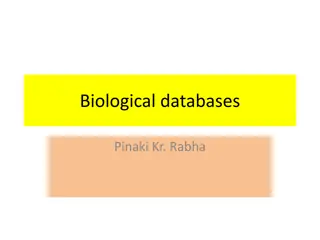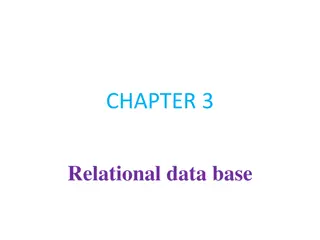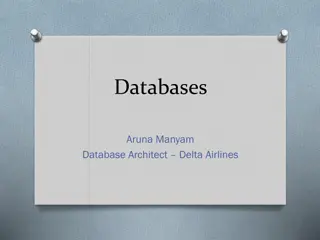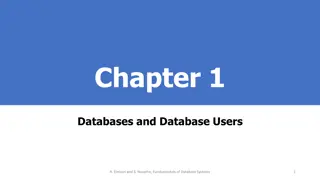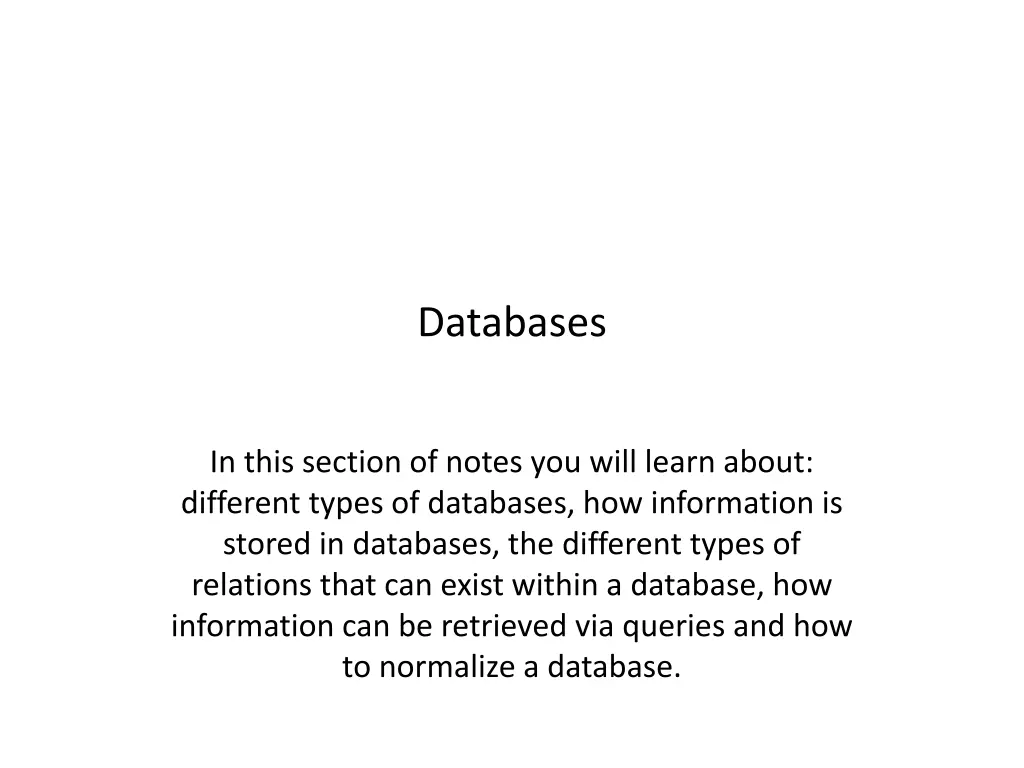
Understanding Databases for Efficient Information Management
Explore the world of databases, including different types, storage mechanisms, relational structures, query retrieval, and normalization. Dive into the importance of organized data for swift access and reduced redundancy in database management.
Uploaded on | 0 Views
Download Presentation

Please find below an Image/Link to download the presentation.
The content on the website is provided AS IS for your information and personal use only. It may not be sold, licensed, or shared on other websites without obtaining consent from the author. If you encounter any issues during the download, it is possible that the publisher has removed the file from their server.
You are allowed to download the files provided on this website for personal or commercial use, subject to the condition that they are used lawfully. All files are the property of their respective owners.
The content on the website is provided AS IS for your information and personal use only. It may not be sold, licensed, or shared on other websites without obtaining consent from the author.
E N D
Presentation Transcript
Databases In this section of notes you will learn about: different types of databases, how information is stored in databases, the different types of relations that can exist within a database, how information can be retrieved via queries and how to normalize a database.
Purpose Of A Database To store information Francesco Rollandin/OpenClipart Database: Customer information
Purpose Of A Database To retrieve information information Sale $$$ Sale $$$ Database: Customer information
Databases: Storing / Retrieving Information As you will see this isn t as easy as it seems. Information must be stored such that: Information can be quickly retrieved
Databases: Storing / Retrieving Information (2) The database is designed to reduce problems during maintenance (additions, modifications, deletions) Example: You will see this actual issue when we talk about database normalization. Information Technology Archie Bunker Marketing Dept. Loren Coleman William McCloud Finance & Accounting Victor Davion Ester Flowers
Databases: Storing / Retrieving Information (3) Minimizes redundancy: Students data base table ID First Name Last Name Phone Class 1 Class 2 123456 Jamie Smyt h 553-3992 CPSC 203, 01 PSYC 205, 03 123457 Stacey Walls 790-3992 ACCT 321, 02 FNCE 353, 05 123458 Angel Lam 551-4993 MATH 211, 02 MATH 251, 01 Classes data base table ClassName CPSC ClassNumber 203 Lecture No 01 ClassDescription Introduction to Computers CPSC 231 01 Introduction to Computer Science I CPSC 233 01 Introduction to Computer Science II
With Bother With Databases? Are used to store and retrieve information Why bother, use a simple file as an alternative? E.g., tracking client information MILES EDWARD O BRIAN DS9 Corp Electrical engineering 2007 purchases: $10,0000,000 2006 purchases: $1,750,000 If the list is short then a simple text file may suffice JAMIE SMYTHE Cooperative services Gasoline refining 2006 purchases: $5,000,0000 2005 purchases: $5,000,0000 2004 purchases: $5,000,0000 2003 purchases: $5,000,0000 2002 purchases: $5,000,0000 As the list grows organizing and updating the information becomes more challenging (duplicates or inaccuracies?) Also searching the list according to specific criteria may become difficult SCOTT BRUCE Bryce Consulting Investment analysis 2007 purchases: $500,000 2006 purchases: $1,500,000 2005 purchases: $2,500,000 2004 purchases: $500,000 e.g., Show all clients whose purchases in 2007 were between one and five million dollars e.g., Show all clients that made a year purchase exceeding 10 million dollars. Etc.
Storing Information In A Database Information is stored in tables: Employees table
Storing Information In A Database (2) Row = Record: An example instance of data within the table. Employees Table: one row is an employee in the organization Records of the table One record, Simpson, Homer
Storing Information In A Database (3) Column: are that attributes that we track for each record Employees Table: each column specifies the information we store about employees in this database. Attributes of each record
Primary Key Each table should typically have one field designated as the primary key: The primary key must be guaranteed to be unique It identifies one record from another Primary Key for table Employees is the SIN field
Choosing A Primary Key A primary key must be unique to each record because it is the one thing that distinguishes them. If there is at least one instance where records can have the same value for a field then that field cannot be a primary key. (When in doubt if this will ever be the case verify with your users). If a single key field cannot be found then several fields can be combined into a composite key. (Each field is still a separate field but together they form a unique primary key for each record). E.g., Course name, course number, lecture section (CPSC 203 L01) If a unique primary key still cannot be found then invent one. E.g., DepartmentID from the Departments table
Example Problem: Tracking Employees You want to store employee and other information. Information we need to track for each employee: Social insurance number Last name First name Address City Province Postal code Home phone number Date of birth Hourly pay rate
Example Problem: Tracking Employee Pay Employees are paid hourly and may work for different departments. A job may cross department bounds e.g., James Tam worked 25 hours on a chemical cleanup job on a chemical spill that occurred on the accounting and HR floor on Jan 15, 2015 to be billed to accounting and human resources. Information we need to track for pay Employee to pay Department to bill for the cost Start date of the work Hours worked Department information Name of the department Annual budget Each department is assigned an ID code: Human Resources = 1, Marketing = 2, Finance = 3, Management information systems = 4
Initial Database Three tables are required and start off with the following attributes: EMPLOYEES SIN LName FName Address City Province Postal code Phone Birth date Hourly pay rate TIMEBILLED Employee info Department Start date Hours worked DEPARTMENTS Department Code Department Name Budget
Refinements Needed: Employees Primary key? EMPLOYEES SIN LName FName Address City Province Postal code Phone Birth date Hourly pay rate
Refinements Needed: Employees Primary key? EMPLOYEES LName FName Address City Province Postal code Phone Birth date Hourly pay rate SIN
Refinements Needed: Departments Primary key? DEPARTMENTS Department Code Department Name Budget
Refinements Needed: Departments Primary key? DEPARTMENTS Department Name Budget Department Code Recall: Human Resources = 1 Marketing = 2 Finance = 3 Management information systems = 4
Refinements Needed: TimeBilled TIMEBILLED Employee info Department Start date Hours worked Primary key? A composite key may be possible With a composite key: It s improbably that there may exist the case there will be duplicates but not impossible E.g., One employee performs two separate jobs for the same department during the same time period that both last the same number of hours. Inventing a primary is the safest solution. TIMEBILLED Employee info Department Start date Hours worked Time BilledID
Refinements Needed: TimeBilled TIMEBILLED Time BilledID Employee info Department Start date Hours worked How to determine which employee to pay? There is already information that uniquely identifies each employee (SIN) We can add the employee Social Insurance number as a new column TIMEBILLED Time BilledID Employee info Department Start date Hours worked SIN
Refinements Needed: TimeBilled TIMEBILLED Time BilledID Employee info Department Start date Hours worked SIN How to determine which department should pay? We can add the department identification as a new column TIMEBILLED Time BilledID Employee info Department Start date Hours worked SIN DepartmentID
Foreign Key A key in one table that refers to a key in another field: E.g. SIN and DepartmentID field of the TimeBilled table
MS-Access Tables Used In The Example This example can be found online: http://pages.cpsc.ucalgary.ca/~tamj/203/topics/databases.html Employees table (tracks information about individual employees) SIN LastName FirstName Address City Province PostalCode HomePhone BirthDate PayRate
Tables Used In The Example (2) Departments table (maps each department to a number e.g., Human Resources = 1, Marketing = 2) DepartmentID DepartmentName Budget TimeBilled table (for each pay period information about how many hours each employee worked and how much they are owed is tracked with this table). TimeBilledID SIN DepartmentID StartPayPeriod HoursWorked
MS-Access: Views Of Your Database Design view Datasheet view Typically start with this view Used to specify what fields that a table will consist of: e.g., DepartmentID, DepartmentName Used to specify the type and the format of the information in each field: e.g., SIN is field with 9 characters that must be in the format 000 000 000 Once the fields have been specified in the Design view using the Datasheet view allows for each record to be entered.
Types Of Tables Data tables Stores data that provides information about the database Dynamic, will likely be manipulated over the life the database (add, delete, modify) E.g. Employees, TimeBilled tables (address and hours worked may change over time) Validation tables Used to ensure data integrity (to lookup values) Typically it maps one value to another (e.g., product to product code, book to ISBN number) Rarely (if ever) changes E.g., Departments table DepartmentID DepartmentName 1 Human Resources 2 Marketing 3 Finance 4 Management Information Systems
Parent And Child Tables A table whose primary key is the foreign key of another table is the parent table. The table whose foreign key is the primary key of another table is the child table. Example: SIN is a foreign key of the TimeBilled table that corresponds to the SIN primary key of the Employees table (CHILD TABLE) SIN: Primary key for Employees table (PARENT TABLE)
Purpose Of Foreign Keys To ensure the integrity of the foreign key. (MS-Access: Ensure referential integrity): as new records are entered in a table with a foreign key as one of the fields, it will ensure that the record will only be entered with a foreign key value that is listed in the appropriate table. SIN is a foreign key referring to the primary key of the EMPLOYEES table. This ensures that a SIN entered in TimeBilled will only be one of the SIN numbers of an actual employee
Null Values Refers to empty fields of a record Primary keys cannot be null but other fields may be null
Types Of Data Integrity In Databases 1. Table-level integrity (entity integrity): Ensuring that no duplicate records exist. Ensuring that no primary keys are null: MS-Access (automatic) indexed no duplicates. 2. Relationship-level integrity (referential integrity): Ensuring that relationship between a pair of tables is sound and the records in the tables are synchronized when data is entered into, updated in or deleted from either table (MS-Access: only partially implemented). 3. Field-level integrity (domain integrity): Ensuring that the values in each field are valid and accurate. In MS-Access this is done through input masks and validation rules.
Input Masks Ensures the proper format for the data entered into the database Example for A2: SIN number in the Employees table must be entered as: <three digits> <space> <three digits> <space> <three digits> Invalid inputs: Abc def ghi 321 22 4234
Validation Rules Validation rules check the data that is entered that it is in the correct range. Examples for A2 (all employ the logical AND): Employees : BirthDate Employees : PayRate TimeBilled : HoursWorked
Guidelines For Naming Tables 1. Create a unique and descriptive name. VehicleMaintenance vs. CarInfo 2. Do not use words that convey physical characteristics or database terminology. File , Record , Table 3. While names should be short avoid using acronyms and abbreviations unless they are well-known. SC = ??? 4. Consider using the plural form of a name. Employees vs. Employee 5. Avoid the use of spaces in names. Undergraduate students vs. Undergraduate_Students
Guidelines For Naming Fields 1. Select a unique and descriptive name (similar to tables). 2. Create a name that accurately, clearly and unambiguously identifies the characteristic that the field represents. Mobile vs. CellPhone or MobilePhone 3. While names should be short avoid using acronyms and abbreviations unless they are well-known (similar to tables). 4. Use the singular form of a name. 5. Avoid the use of spaces in names (similar to tables).
Relationships Between Tables Relationships occur when a field of one table is a foreign key in another table. Multiplicity: indicates how many instances of a particular item participates in the relationship: 1. One to one 2. One to many 3. Many to many
Multiplicity 1. One to one relationships One entity participates in the relationship from the left and one entity participates in the relationship from the right . Person : head Worker : Social Insurance Number This type of relationship is rare in databases 2. One to many relationships On one side of the relationship one entity participates in the relationship while on the other side: zero or more entities may participate in the relationship. Person : Hair Employees : TimeBilled : Departments
Multiplicity (2) 3. Many to many relationships On each side of the relationship zero or more entities may participate in the relationship. Students : Classes
Multiplicity (3) 3. Many to many relationships This type of relationship is not directly implemented in databases: Students table StudentID StudentFirst Name Jamie StudentLastName StudentPhone 123456 Smyth 553-3992 123457 Stacey Walls 790-3992 123458 Angel Lam 551-4993 Classes table Class Name CPSC Class Number 203 Lecture No 01 ClassDescription Introduction to Computers CPSC 231 01 Introduction to Computer Science I CPSC 233 01 Introduction to Computer Science II
Multiplicity (4) 3. Many to many relationships Typically implemented as two one to many relationships in databases: Classes table Students table Class Name CPSC Class Number 203 Student ID 123456 StudentFirst Name Jamie 123457 Stacey CPSC 231 Registrations table (linking table) Student ID ClassName Class- Numbe r 201 Lecture No 123450 ENGL 01 123457 CPSC 203 01 123460 MATH 271 01
Many : Many, What If The Rule Is Ignored? Students table StudentID StudentFirst Name StudentLast Name 123456 Jamie Smyth 123457 Stacey Walls 123458 Angel Lam Class 1 Class 2 Class 3 Class 4 Class 5 Class N CPSC 203 PSYC 205 MATH 221 MATH 251 SOCI 201 NULL CPSC 203 ART 201 MATH 271 NULL NULL NULL CPSC 203 CHIN 201 KINE 221 MGIS 323 OPMA 341 NULL
Many : Many, What If The Rule Is Ignored? (2) Classes table Class Name Class Number Lecture No ClassDescription CPSC 203 01 Introduction to Computers CPSC 231 01 Introduction to Computer Science I CPSC 233 01 Introduction to Computer Science II S1 S6 S7 SN S2 S3 S4 S5 Bill Bob Mary Jane NULL NULL NULL NULL Jim NULL NULL NULL NULL NULL NULL NULL Alice Brett Charlie Deaco n Ernie Edgar Freda NULL
Diagrammatically Representing Databases Entity-Relation diagrams (E-R Diagrams or E.R.D. s): show the fields of a table. Format TABLE NAME Primary key Attribute Attribute Example DEPARTMENTS DepartmentID DepartmentName Budget
Primary : Foreign Keys Again When there is a one to many relationship the primary key of the one side becomes a foreign key on the many side. Examples: 1 Many Employees : TimeBilled SIN: Primary key SIN: Foreign key 1 Many Departments : TimeBilled DepartmentID: Primary key DepartmentID: Foreign key
Diagrammatically Representing Relationships Graphically representing relationships between tables as well as any enforced rules on multiplicity: 1 1 Person Head * 1 Person Hairs * * * * Students Classes Classes Students Registrations 1 1
The ERD For The Example Database Employees SIN DEPARTMENTS LastName 1 DepartmentID FirstName DepartmentName Address 1 Budget City TimeBilled Province PostalCode TimeBilledID HomePhone SIN BirthDate * DepartmentID PayRate * StartPayPeriod HoursWorked
Database Queries Queries are questions asked of/to the database in order to retrieve information.
Retrieving Data Via Queries Data retrieval occurs through the use of queries : A query is a question asked of the data in the database. Typically worded to show only the parts of the database for which the answer to the question is true. Example: What is the SIN, name and pay rate of every employee in the Employees Table: Query Result of the query
Retrieving Data Via Queries (2) Query Example: What is the SIN, name & address of all employees that have the last name of Morris? Query Result of the query
Databases And Set Theory Each table can be viewed as a set of information. EMPLOYEES (TABLE/SET) * 456 789 123, Cartman Eric, Southpark * 456 789 124, Simpson Homer, Springfield * 666 666 666, Morris Heather, Silent Hill * 666 666 667, Mason Harry, Silent Hill * 670 380 456, Edgar Maureen, Calgary Departments (TABLE/SET) * 1, Human Resources * 2, Marketing * 3, Finance * 4, Management Information Systems TimeBilled (TABLE/SET) * 8, 456 789 123, 2, 10/1/2007, 80 * 9, 456 789 124, 2, 10/1,2007, 60 * 14, 666 666 666, 3, 10/1/2007, 50 * 15, 666 666 667, 3, 10/1/2007, 50 * 18, 670 380 456, 4, 10/1/2007, 40





